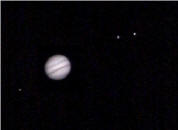|

www.AstroMax.com
Up
Abstract
I. Purpose
II. Background
III. Orbits
IV. Period Determination
V. Methods
VI. Kepler's Laws
VII. Observing Suggestions
VIII. Data Gathering
IX. Data Processing
X. Observer's Data Results
XI. Other Quad-A Results
XII. Conclusions
XIII. Attachments

This Project Jupiter Report
was prepared by
Mizar Consulting
Eugene A. Lanning
130 Hillside Terrace
Nebraska City, NE
68410-3740
ealanni@alltel.net
Member of AAAA
AAAA
The American Association
of Amateur Astronomers
P.O. Box 7981
Dallas, TX
75209-0981
e-Mail:
aaaa@astromax.com
www.AstroMax.com
| |
 Project
Jupiter Project
Jupiter
 
VI. Kepler’s Third Law
Project Jupiter will be using an enhanced version of Kepler’s Third
Law, an enhancement that considers Newton’s Law of Gravitation.
A. Who was Kepler?
 Johannes
Kepler was a German mathematician and astronomer who lived from 1571 to
1630. At the time Kepler was alive, Newton’s Law of Gravitation was not
yet discovered
( 8 )
, so Kepler’s Third Law is expressed as a
proportion rather than an equation. Johannes
Kepler was a German mathematician and astronomer who lived from 1571 to
1630. At the time Kepler was alive, Newton’s Law of Gravitation was not
yet discovered
( 8 )
, so Kepler’s Third Law is expressed as a
proportion rather than an equation.
B. The Laws of Kepler
Based on his observations, Kepler developed three revolutionary
thoughts. Thoughts that have withstood the test of time and scientific
scrutiny to rise to the classification of a "Law". His Laws,
paraphrased, are:
- The shape of a planetary orbit is an ellipse. The same hold true
for the orbital shape of a moon about a planet. For ellipses, there
are two "centers" (called foci ) rather than just one center as for a
circle. The more massive of the objects being orbited is located at
one of the foci.
- A line connecting the planet and the sun sweeps over equal areas
in equal time periods. Again, the same is Law applies for a moon
orbiting a planet.
- The square of the sidereal period
9
of a planet is proportional to the cube of
the semi-major axis distance the planet is from the sun. Again, this
Law holds for any moon orbiting a planet.

In the exaggerated diagram above, the semi-major axis length is
labeled as ‘a’. Because of the mass of the sun, the difference between
distance a and distance Rp
is actually small.
C. Examining Law #3
Law #3 is the Law that enables us to "weigh" Jupiter in Project
Jupiter, when combined with the Law of Gravitation. For the
mathematically inclined, the mathematics are presented in
Attachment D. Attachment D is the solution for a circular orbit, an
approximation that does not contribute too much uncertainty for Project
Jupiter.
Normally an observation series like Project Jupiter is done in a
college-level astronomy course. One exciting strength of Quad-A is that
its members share expertise freely. This writeup is one such example of
shared expertise that is intended to allow all Quad-A members to
participate in this project, as the member need not personally fuss with
the attendant mathematics.
8 Newton’s laws were formulated
around 1666, and published in 1687.
|
[Home]
[Abstract]
[I. Purpose]
[II. Background]
[III. Orbits]
[IV. Period Determination]
[V. Methods]
[VI. Kepler's Laws]
[VII. Observing Suggestions]
[VIII. Data Gathering]
[IX. Data Processing]
[X. Observer's Data Results]
[XI. Other Quad-A Results]
[XII. Conclusions]
[XIII. Attachments]
|



 Johannes
Kepler was a German mathematician and astronomer who lived from 1571 to
1630. At the time Kepler was alive, Newton’s Law of Gravitation was not
yet discovered
( 8 )
, so Kepler’s Third Law is expressed as a
proportion rather than an equation.
Johannes
Kepler was a German mathematician and astronomer who lived from 1571 to
1630. At the time Kepler was alive, Newton’s Law of Gravitation was not
yet discovered
( 8 )
, so Kepler’s Third Law is expressed as a
proportion rather than an equation.
